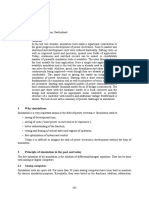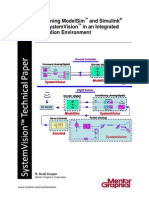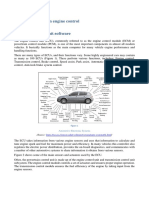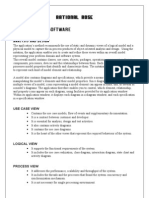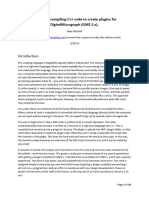351 792 1 SM
351 792 1 SM
Uploaded by
Iulia MunteanuCopyright:
Available Formats
351 792 1 SM
351 792 1 SM
Uploaded by
Iulia MunteanuOriginal Title
Copyright
Available Formats
Share this document
Did you find this document useful?
Is this content inappropriate?
Copyright:
Available Formats
351 792 1 SM
351 792 1 SM
Uploaded by
Iulia MunteanuCopyright:
Available Formats
Stateflow a Useful Tool for Developing New Logic Algorithms. Case Study: Building a State Machine for Windscreens.
Software System
Claudiu Munteanu , Gheorghe Livin and Gabriel Chiriac
Department of Electrical Engineering Technical University of Iai 700050, Iai, Romania E-mail: clau_matrix_00@yahoo.com
Abstract - This paper is about how we can develop a new software design without using all standard steps of a V-cycle or to add new methods to test and verify the model against the requirement. For that purpose we chose case study and we reveal how that thing is doing. All subsystems without one exception are built in Stateflow. The microcontroller subsystem has five peripheral implemented and two logical charts for interruption and priority interruption system. Stateflow is a very useful tool to create complex algorithms, to interact with C and C++ and he can predict all feature steps if you now the present state. Keywords - ANSI-C, microcontroller, chart, linearization, ISR, integrate, PID, C programming language and Object Orientated Programming
There are some important subsystems: timer peripheral, input capture peripheral, input-output peripheral, Interrupt Service Routine controller, Interrupt Priority controller, ANSIS chart and windows logic implementation. In Fig. 1 is depicted the requirements word document.
I. INTRODUCTION In the very beginning we can make a short introduction about V-cycle which has a great interest in developing new software. V-cycle has some steps: first of all is the requirements step next is design step, implementation state, testing and the final one is verification and validation stage. The requirements stage needs some documentation received from customers. Based through documentation we can analyze the functional and the non-functional requirements and then to make the linkage between word document and matlab. II. REQUIREMENTS AND C FUNCTIONS Every connection maintains the relation between software model and documentation throughout V-cycle. In our requirements list there are only functional elements but in real software development it is necessary also some non-functional statements like: shape, aesthetics and so on. Our case study is about a windows system which has some functions: up-down window for four passengers, parents control, detect object. The entire system is made of charts in Stateflow.
Figure 1. Requirements
Next step is to develop the model based design and this thing is built with Matlab environment. First step is to implement the ANSI-C code state chart. The state chart is composed from initial state, running state and final state. The purpose of the first state is to initialize the C function. Stateflow has one major feature and that is the C function import. So with this functionality is easy to implement easier and faster our code. It is not necessary anymore to develop the model, to convert into z model and finally to generate code. Init function is made in C programming language, it has a header and a C file. In header there are defined the bit fields which are referred to peripheral registers as we can see depicted below (Fig. 2).
The while loop it`s composed of PID function and fun function. PID function is the C function which implements the behavior of a PID controller. The kp is the proportional gain, the ki is the integral gain, err is the difference between reference and measure values, the I is the integral value which is represented by a sum of errors. The C algorithm is implemented in Fig. 4.
Figure 2. Bus header
For example the ISR register contain four fields. All fields are made to call interrupts when the interrupt enable bit is set. The C source file is showed in Fig. 3 and we can see the definition of struct function and also the initialization of fields of interest.
Figure 4. C PID function definition
The sum of P and I are limited between some maximum and minimum values. The ANSI-C chart act like a C function which then is compiled and linked results an object file. The hex file is used to programming the microcontroller. We use the C program model and the microcontroller hardware model in the same environment. III. MAIN PROGRAM The ANSI-C chart contains the algorithm used to control the microcontroller in the way that we want (to detect object and to react etc.). The brain of model is ANSI-C chart which is depicted in Fig. 5.
Figure 3. Bus C function definition
In the same time all of structures are gathered in one new structure which is named bus. This (bus) structure is a data bus because this one manages and controls the behavior of the bit fields throughout of peripheral simulink systems. Init function is called by reference and is a very useful thing because we work with pointers inside of chart. We can use all of kind of pointers: pointers to structure, pointers to array, multilevel pointers and so on. Stateflow has some control flow pattern but together with pointers, unions, structures and bit operations we can model complex structure for embedded systems.
Figure 5. ANSI-C main chart
The final state is called terminate and is active when the simulation time is two hundred. The while loop is made with Stateflow pattern it is running only for two hundred seconds. When start_program variable is in high position than the state of chart is passing to the next state and after that when simulation time reach the threshold the animation and the simulation is over. The interaction between header definition and bus system from Simulink is made with an interface where user has to make the fields regarding to structures. For example next picture (Fig. 6) details how is made this procedure.
Figure 7. PID Tunning
The above picture describes how tuning process is made. We only has to slide the rapidity of controller and the kp, ki, Ts are generated automatically. In addition the graphical user interface gives us a lot of information of quality parameters: stability, rise time, steady state response, overshot, undershot.
Figure 6. Bus definition GUI
IV. CONCLUSION The interaction between C and Stateflow is a very useful strategy to build complex structure or to represents the behavior of the system. I used a lot of new methods for developing in matlab and I worked in Stateflow tool, Simulink tool.
As we can see the entire bus model is a nested structures which has three layers: the high layer is named bus which contain nine fields and every field contain register fields.In our study case we tried to use different ways for testing and validation than V-cycle standard software development. Matlab offers some benefits like: using physical design instead of mathematic design. So I use as possible I could to use logical model instead mathematical design. Our model is divided into three major parts: the C code, microcontroller part and vehicle subsystem. The vehicle subsystem is the mathematical model of vehicle. This model was initial a physical system formed from physical parts: diesel engine, transmission, torque convertor, gear speed, differential and wheels. This system is linearized to obtain a linear model. Based on this model we tune the PID controller and the constant gain, integral gain and sample time (Fig. 7).
REFERENCES
MATLAB Stateflow Toolbox Users Guide [Online]. [2] MATLAB SimDriveline Users Guide [Online]. [3] www.mathworks.com [4] http://ocw.mit.edu/courses/
[1]
You might also like
- Chapter 3 DroneDocument12 pagesChapter 3 DroneZero MrNo ratings yet
- Create A Simple ABAP CDS View in ADTDocument71 pagesCreate A Simple ABAP CDS View in ADTAmit KumarNo ratings yet
- Study of Model Predictive Control Using Ni LabviewDocument10 pagesStudy of Model Predictive Control Using Ni LabviewBrankko Jhonathan Torres SaavedraNo ratings yet
- 1-Program Design and AnalysisDocument6 pages1-Program Design and AnalysisUmer AftabNo ratings yet
- State MachinesDocument47 pagesState Machinesinfo5280No ratings yet
- Central Ticketing System - SRSDocument39 pagesCentral Ticketing System - SRSSriram VishwanathNo ratings yet
- Visualization and Simulation in SchedulingDocument3 pagesVisualization and Simulation in Schedulingmac2022No ratings yet
- Automatic Generation A Way of Ensuring PLC and HMI StandardsDocument4 pagesAutomatic Generation A Way of Ensuring PLC and HMI Standardsrcfrcf279No ratings yet
- Online Railway Reservation SystemDocument16 pagesOnline Railway Reservation Systemkenyjain33% (3)
- Object Oriented C++ Programming in SIMULINK - A Reengineered Simulation Architecture For The Control Algorithm Code ViewDocument6 pagesObject Oriented C++ Programming in SIMULINK - A Reengineered Simulation Architecture For The Control Algorithm Code Viewgreen_way26No ratings yet
- Report PDFDocument11 pagesReport PDFshahNo ratings yet
- Coupler Curve System PDFDocument11 pagesCoupler Curve System PDFshahNo ratings yet
- Matrimonial Portal DocumentDocument11 pagesMatrimonial Portal DocumentthangatpNo ratings yet
- Jorge L. Silva, Joelmir J. Lopes Valentin O. Roda, Kelton P. CostaDocument4 pagesJorge L. Silva, Joelmir J. Lopes Valentin O. Roda, Kelton P. CostaSimranjeet SinghNo ratings yet
- Data ManagementDocument7 pagesData ManagementDeepak ChachraNo ratings yet
- Simulation Approach On Step Speed Control of Induction Motor Using Lab ViewDocument6 pagesSimulation Approach On Step Speed Control of Induction Motor Using Lab ViewCristian Ágreda AlvarezNo ratings yet
- Simulation Tools: F. JenniDocument21 pagesSimulation Tools: F. JenniAmy HicksNo ratings yet
- Railway Reservation SystemDocument18 pagesRailway Reservation Systempoovizhi27beNo ratings yet
- Matlab Project FileDocument27 pagesMatlab Project FileHimanshu ShisodiaNo ratings yet
- An Efficient C++ Framework For Cycle-Based Simulation: September 2002Document7 pagesAn Efficient C++ Framework For Cycle-Based Simulation: September 2002prasanna_npNo ratings yet
- Computer Project 2020Document46 pagesComputer Project 2020Ganesh ArenaNo ratings yet
- Computer Science SalybusDocument11 pagesComputer Science SalybusAdil ShahNo ratings yet
- Main Report CGDocument105 pagesMain Report CGAshish MorambeNo ratings yet
- ATEE 2004 Ilas 4.1Document6 pagesATEE 2004 Ilas 4.1electrotehnicaNo ratings yet
- From Design To Implementation: Linear ControllersDocument22 pagesFrom Design To Implementation: Linear Controllersสหายดิว ลูกพระอาทิตย์No ratings yet
- Job SequencingDocument38 pagesJob SequencingSameer ɐuɥsıɹʞNo ratings yet
- Aim: Phases of Software Development Project, Overview, Need, Coverage of TopicsDocument3 pagesAim: Phases of Software Development Project, Overview, Need, Coverage of TopicsHarshil ShahNo ratings yet
- Systemc in QT GUI PDFDocument11 pagesSystemc in QT GUI PDFSurendhartcNo ratings yet
- 7B99659Document4 pages7B99659TYu4443No ratings yet
- Robot Simulation and Off-Line Programming: S. F. Chan, Prof. Weston and CaseDocument6 pagesRobot Simulation and Off-Line Programming: S. F. Chan, Prof. Weston and CasedatdrakuNo ratings yet
- BLDC Motor Control Design in Matlab/Simulink: Vladimír Hubík, Jiří Toman, Vladislav SinguleDocument5 pagesBLDC Motor Control Design in Matlab/Simulink: Vladimír Hubík, Jiří Toman, Vladislav SinguleWilliam Javier Rosero VargasNo ratings yet
- Identification of Longitudinal Aircraft Dynamics by Process Model Using Matlab/SimulinkDocument4 pagesIdentification of Longitudinal Aircraft Dynamics by Process Model Using Matlab/SimulinkEditor IJSETNo ratings yet
- C&DS NotesDocument98 pagesC&DS NotesAnanth NathNo ratings yet
- Coverage Analysis For Model Based Design Tools: William Aldrich The Mathworks, Inc. 3 Apple Hill Dr. Natick, Ma 02478Document17 pagesCoverage Analysis For Model Based Design Tools: William Aldrich The Mathworks, Inc. 3 Apple Hill Dr. Natick, Ma 02478Lindung SiswantoNo ratings yet
- SET 1erDocument2 pagesSET 1errooneeNo ratings yet
- NI-Tutorial-6163, Build A Hybrid Control System With NI LabVIEWDocument4 pagesNI-Tutorial-6163, Build A Hybrid Control System With NI LabVIEWgmagi169337No ratings yet
- Sit725 4 AnalysisModel 2 PDFDocument8 pagesSit725 4 AnalysisModel 2 PDFGaurang PatelNo ratings yet
- Combining ModelSim and Simulink With SystemVision in An Integrated Simulation EnvironmentDocument5 pagesCombining ModelSim and Simulink With SystemVision in An Integrated Simulation Environmentleo3001No ratings yet
- Visual Debugging and Automatic Animation of C ProgramsDocument10 pagesVisual Debugging and Automatic Animation of C Programsjadhavkalpesh881No ratings yet
- Intro To LV in S For Control and SimDocument76 pagesIntro To LV in S For Control and SimAdriano NavarroNo ratings yet
- Internal Combustion Engine Control 1. Engine Control Unit SoftwareDocument10 pagesInternal Combustion Engine Control 1. Engine Control Unit SoftwareLahcen KhalifNo ratings yet
- ME270 Final Project KanekoDocument5 pagesME270 Final Project KanekoAlif DarsimNo ratings yet
- Predictable Parallel Performance The BSP ModelDocument34 pagesPredictable Parallel Performance The BSP ModelegondragonNo ratings yet
- Courier Management System Project PHPDocument46 pagesCourier Management System Project PHPmanchi saijeevan0% (1)
- Rapid Control Prototyping and Hardware-In-The-Loop Using XPC TargetDocument6 pagesRapid Control Prototyping and Hardware-In-The-Loop Using XPC TargetOsman KutluNo ratings yet
- Item - Fixed LRIC Model User GuideDocument196 pagesItem - Fixed LRIC Model User GuideSead KurtovićNo ratings yet
- Beating C in Scientific Computing Applications: On The Behavior and Performance of L, Part 1Document12 pagesBeating C in Scientific Computing Applications: On The Behavior and Performance of L, Part 1cluxNo ratings yet
- Real-Time Control Implementation of Simple Mechatronic Devices Using MATLAB/Simulink/RTW PlatformDocument12 pagesReal-Time Control Implementation of Simple Mechatronic Devices Using MATLAB/Simulink/RTW Platformఅయ్యలసోమయాజుల సాయి శివNo ratings yet
- Approach For Implementing Object-Oriented Real-Time Models On Top of Embedded TargetsDocument7 pagesApproach For Implementing Object-Oriented Real-Time Models On Top of Embedded Targetsanandkumarrs6No ratings yet
- Ooad Lab Manual-1 JNTUHDocument41 pagesOoad Lab Manual-1 JNTUHnirmalNo ratings yet
- Ooad LabDocument149 pagesOoad LabNelson GnanarajNo ratings yet
- Simulation and Animation of Mechanical Systems Very IMPDocument11 pagesSimulation and Animation of Mechanical Systems Very IMPHareesha N GNo ratings yet
- Structured PLC Programming With Sequential Function Charts: James A. Rehg Pennsylvania State UniversityDocument6 pagesStructured PLC Programming With Sequential Function Charts: James A. Rehg Pennsylvania State UniversityQm Lương Văn MinhNo ratings yet
- Milp Base PaperDocument4 pagesMilp Base PapervenkateshjuturuNo ratings yet
- EMT Simulation Integrating With Other ToosDocument5 pagesEMT Simulation Integrating With Other ToosjdebnathNo ratings yet
- Big Data Analytics in Intelligent Transportation Systems A SurveyDocument20 pagesBig Data Analytics in Intelligent Transportation Systems A SurveyNirmal GemesNo ratings yet
- Simulation and Control of A Robotic Arm Using MATLAB Simulink and TwinCATDocument5 pagesSimulation and Control of A Robotic Arm Using MATLAB Simulink and TwinCATsindhushetty06No ratings yet
- Five-Step UML: OOAD For Short Attention Spans - Design, RepeatDocument13 pagesFive-Step UML: OOAD For Short Attention Spans - Design, RepeatPraveen KumarNo ratings yet
- MATLAB QuestionsDocument17 pagesMATLAB QuestionsSRIRAM TRIPURANENINo ratings yet
- Linear ControlDocument22 pagesLinear ControlElvis YuNo ratings yet
- Systems Analysis and Design 10th EditionDocument49 pagesSystems Analysis and Design 10th EditionBurime GrajqevciNo ratings yet
- How To Install VMware Tools On RHELDocument3 pagesHow To Install VMware Tools On RHELgutha babuNo ratings yet
- Gnu MPDocument138 pagesGnu MPKenta MurataNo ratings yet
- Sop - Form STD - Logic STD - Logic Sop - Form Arch Sop - FormDocument4 pagesSop - Form STD - Logic STD - Logic Sop - Form Arch Sop - FormKshitij GurjarNo ratings yet
- Capgemini Pseudocode Question BankDocument39 pagesCapgemini Pseudocode Question BankSrijaNo ratings yet
- Euphoria DocumentationDocument63 pagesEuphoria Documentationkhodejakhatun341No ratings yet
- Micro Degree SampleDocument17 pagesMicro Degree SampleNavyaNo ratings yet
- MVC SpecificationDocument15 pagesMVC SpecificationBhargav Raju0% (1)
- Introduction To Programming LanguagesDocument69 pagesIntroduction To Programming LanguagesPink PastaNo ratings yet
- Microsoft Visual C++ 2008 Express Edition TutorialDocument21 pagesMicrosoft Visual C++ 2008 Express Edition TutorialjuiriarteNo ratings yet
- Apex Interview QuestionsDocument17 pagesApex Interview QuestionsAbhi HivraleNo ratings yet
- Microsoft Visio TrainingDocument52 pagesMicrosoft Visio TrainingUmair ZaheerNo ratings yet
- SRS - IEEE Group 4Document20 pagesSRS - IEEE Group 4habteyesus TadesseNo ratings yet
- DBMS 07Document5 pagesDBMS 07DmdhineshNo ratings yet
- Event StudioDocument13 pagesEvent Studiokilla12No ratings yet
- Chapter 8 - SearchingDocument44 pagesChapter 8 - SearchingMuhammad NazmiNo ratings yet
- DevOps With Laravel - Sample ChapterDocument72 pagesDevOps With Laravel - Sample ChapterJendela KayuNo ratings yet
- Nancyli Resume - Software - Eng C#Document4 pagesNancyli Resume - Software - Eng C#Madhav GarikapatiNo ratings yet
- 12-Web ServicesDocument20 pages12-Web ServicesDanial KayaniNo ratings yet
- OLC Induction Program - 20-Jan-2023Document9 pagesOLC Induction Program - 20-Jan-2023HjhjhNo ratings yet
- SAP IDOC Tutorial - Definition, Structure, Types, Format & TablesDocument13 pagesSAP IDOC Tutorial - Definition, Structure, Types, Format & TablesDaniela Estefania Ramirez LandaetaNo ratings yet
- OS MCQ (Part 2)Document20 pagesOS MCQ (Part 2)sagnik pandaNo ratings yet
- Slip Test 12 QPDocument2 pagesSlip Test 12 QPNeymar AshwinNo ratings yet
- MVC Life CycleDocument5 pagesMVC Life CycleNaga Sai BabuNo ratings yet
- XML SchemaDocument62 pagesXML Schemaag_krishNo ratings yet
- Tutorial Compiling Plugins For GMS2Document10 pagesTutorial Compiling Plugins For GMS2Biju KuttanNo ratings yet
- Internship Assessment Report On: Prakash Gupta 1812210083 Under The Guidance of Er. Devendra KumarDocument26 pagesInternship Assessment Report On: Prakash Gupta 1812210083 Under The Guidance of Er. Devendra KumarAditya SinghNo ratings yet
- Refactoring PDFDocument43 pagesRefactoring PDFTavo HdzNo ratings yet
- Time-Controlled Interrupts With The S7-22xDocument2 pagesTime-Controlled Interrupts With The S7-22xwww.otomasyonegitimi.comNo ratings yet
















